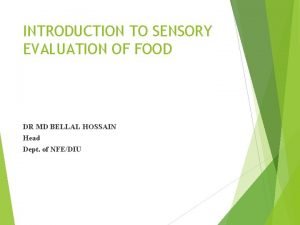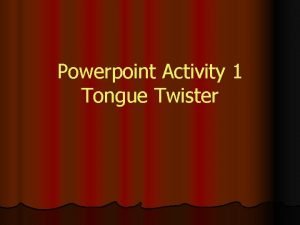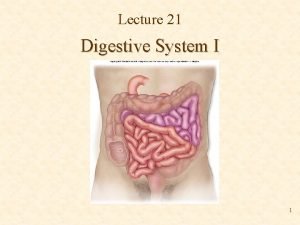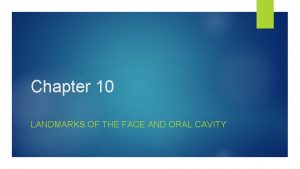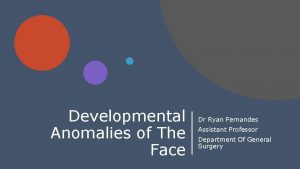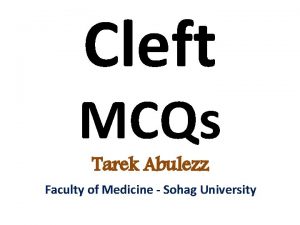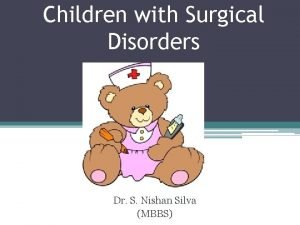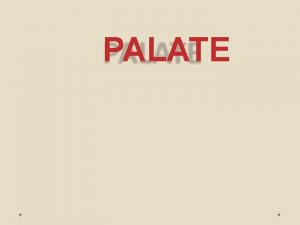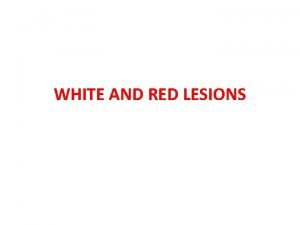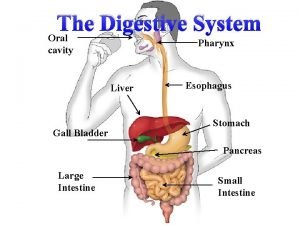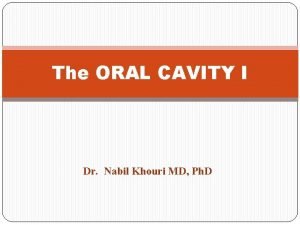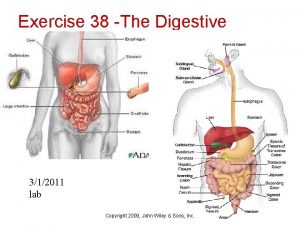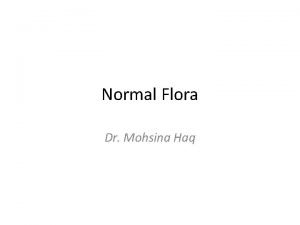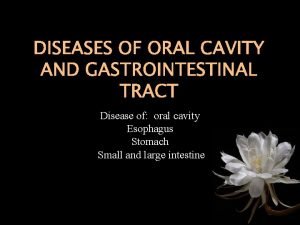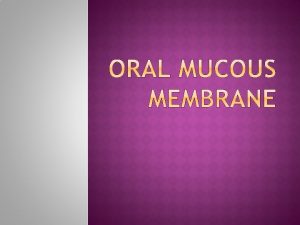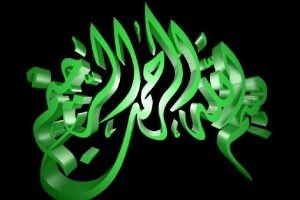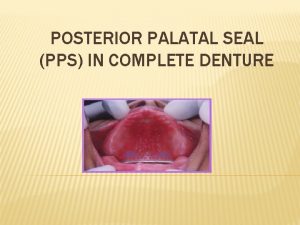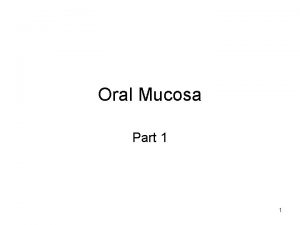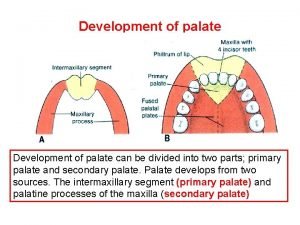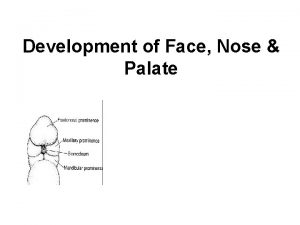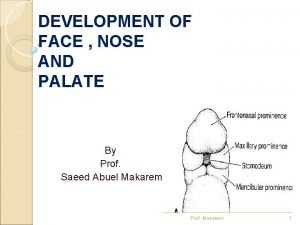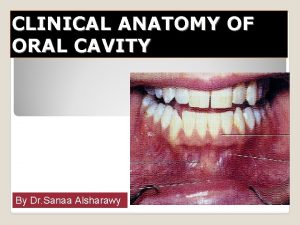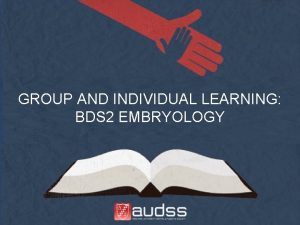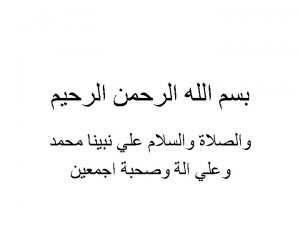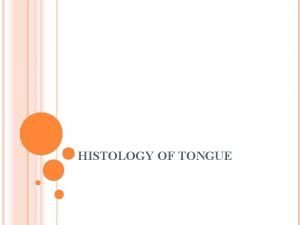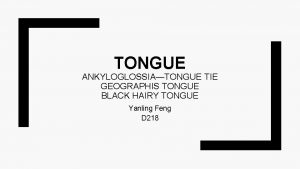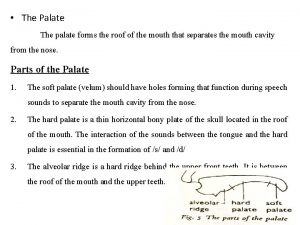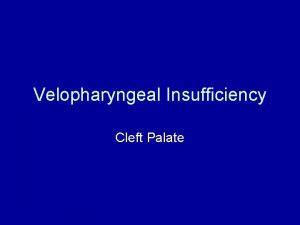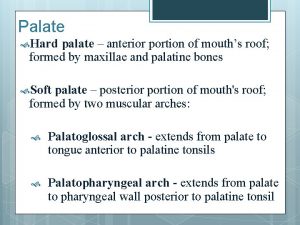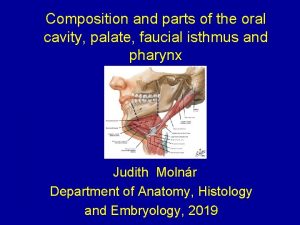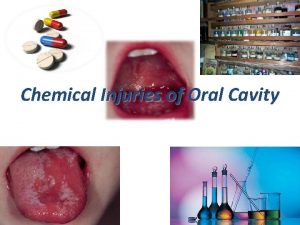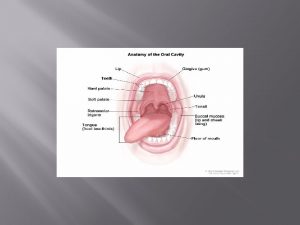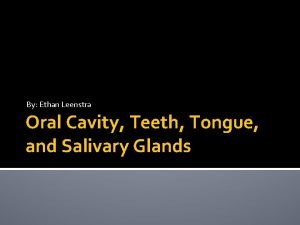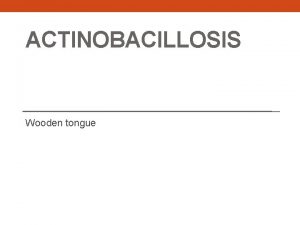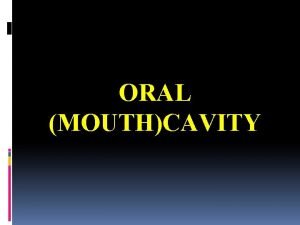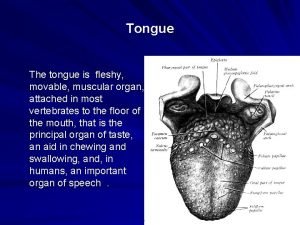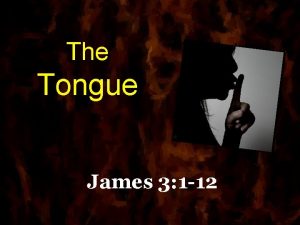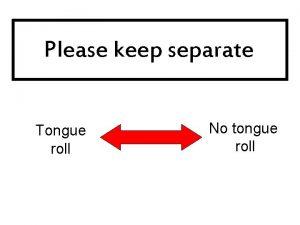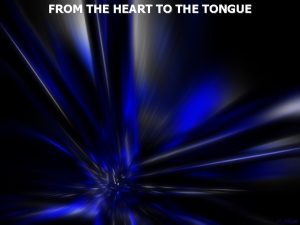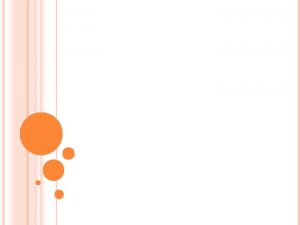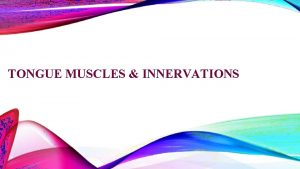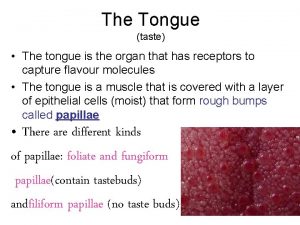ORAL CAVITY PALATE AND TONGUE ORAL CAVITY Prof




































- Slides: 36

ORAL CAVITY PALATE AND TONGUE ORAL CAVITY Prof. Saeed Abuel Makarem

OBJECTIVES By the end of the lecture you should be able to: Describe the anatomy of the oral cavity, (boundaries, parts, nerve supply). Describe the anatomy of the palate, (parts, muscles, nerve & blood supply). Describe the anatomy of the tongue, (structure, muscles, motor and sensory nerve, blood supply and lymphatic drainage). 2

The mouth extends from lips anteriorly to the oropharyngeal isthmus posteriorly (which is the junction of the mouth with the pharynx). It is divided into the 1 - Vestibule: Which lies between gums & teeth internally and, Lips & cheeks externally. 2 - Mouth cavity proper: Which lies within the alveolar arches, gums, and teeth. Prof. Saeed Abuel Makarem

VESTIBULE Prof. Saeed Abuel Makarem Vestibule: It is a slit-like space that communicates with the exterior through the oral fissure. When the jaws are closed, it communicates with the mouth proper behind the last molar tooth.

The cheek forms the lateral wall of the vestibule and is made up of the buccinator muscle, which is covered by skin and lined by mucous membrane. Opposite the upper second molar tooth, there is a small papilla on the mucous membrane, marking the opening of the parotid duct. CHEEK Prof. Saeed Abuel Makarem

MOUTH Mouth proper: has a Roof: which is formed by the hard & soft palate. § Floor: which is formed by the anterior 2/3 of the tongue, (oral or palatine part of the tongue). Prof. Saeed Abuel Makarem

PALATE The palate forms the roof of the mouth. It is divided into two parts: ◦ Hard or (Bony) palate in front and ◦ Soft palate behind. Prof. Saeed Abuel Makarem

HARD PALATE The hard palate is formed by 4 bones: 2 palatine processes of the maxillae anteriorly and the 2 horizontal plates of palatine bones posteriorly. The 4 bones are separated by cruciform suture. It is bounded laterally by the alveolar arches, and behind it is continuous with the soft palate. Prof. Saeed Abuel Makarem It forms the floor of the nasal cavities.

SOFT PALATE Prof. Saeed Abuel Makarem Soft palate is a mobile fold of mucous membrane attached to the posterior border of the hard palate. In its free posterior border there is a conical projection called the uvula.

The soft palate is composed of: 1 - Mucous membrane, 2 - Palatine aponeurosis, 3 - Muscles. 4 - Nerves and vessels. Mucous membrane covers its upper & lower surfaces. The palatine aponeurosis is a fibrous sheet attached to the posterior border of the hard palate. It is the expanded tendon of the tensor palatini. Prof. Saeed Abuel Makarem

Sensory innervation Nerve Supply of the Palate The greater and lesser palatine nerves from maxillary nerve, enter the palate through greater and lesser palatine foramina. The nasopalatine nerve, also a branch of the maxillary nerve, enters the palate through the incisive foramen. The glossopharyngeal nerve also supplies the soft palate. Prof. Saeed Abuel Makarem

MUSCLES OF THE SOFT PALATE 5 pairs of muscles 1 -Tensor veli palatini, (or tensor palati). 2 -Levator veli palatini, (or levator palati). 3 -Palatoglossus, 4 -Palatopharyngeus, 5 -Musculus uvulae. Prof. Saeed Abuel Makarem

The muscle fibers of the tensor palatini converge as they descend from their origin to form a narrow tendon, which turns medially around the pterygoid hamulus. TENSOR VELI PALATINI The tendon, together with the When the muscles of the two sides contract, the soft palate is tightened tendon of the opposite side, so it moves upward as a tense sheet. expands to form the palatine aponeurosis. Prof. Saeed Abuel Makarem

PALATINE APONEUROSIS Prof. Saeed Abuel Makarem

LEVATOR VELI PALATINI Prof. Saeed Abuel Makarem

PALATOPHARYNGEUS Prof. Saeed Abuel Makarem

PALATOGLOSSUS Prof. Saeed Abuel Makarem

MUSCULUS UVULAE Prof. Saeed Abuel Makarem

Prof. Saeed Abuel Makarem

BLOOD SUPPLY OF THE PALATE Greater & lesser palatine branches of the maxillary artery. Ascending palatine branch of the facial artery. Ascending pharyngeal branch of the external carotid artery.

MOVEMENTS OF SOFT PALATE Prof. Saeed Abuel Makarem The pharyngeal isthmus (Communication between nasal and oral parts of the pharynx). It is closed by raising the soft palate upwards. Closure occurs during the production of explosive acts as in speech and straining. Soft palate is raised by the levator palatini on each side, and become tense by tensor palati. At the same time, the superior constrictor muscle contract and pull the posterior pharyngeal wall forward. The palatopharyngeus muscles on both sides also contract so that the palatopharyngeal arches are pulled medially, like side curtains.

The tongue is a mass of striated muscle covered with mucous membrane. Its anterior 2/3 lies in the mouth, and its posterior 1/3 lies in the pharynx. Muscles attach the tongue to the styloid process & soft palate above and to the mandible & the hyoid bone below. The tongue is divided into right & left halves by a median fibrous septum. TONGUE Prof. Saeed Abuel Makarem

Mucous Membrane of the The mucous membrane of upper surface of the tongue can be divided Tongue into anterior 2/3 or oral part and posterior 1/3 or pharyngeal part by a V-shaped sulcus. The sulcus terminalis. • The apex of the sulcus projects backward and is marked by a small pit, the foramen cecum. The foramen cecum is an embryologic remnant which marks the site of the upper end of the thyroglossal duct.

Three types of papillae are present on the upper surface of the anterior two thirds of the tongue: the filiform papillae, the fungiform papillae, and the vallate papillae. The mucous membrane covering the posterior third of the tongue is devoid of papillae but has a nodular irregular surface caused by the presence of underlying lymph nodules, the lingual tonsil. The posterior third has no papillae and only has lingual tonsil. Prof. Saeed Abuel Makarem

The mucous membrane on the inferior surface of the tongue is smooth and is reflected from the tongue to the floor of the mouth. In the midline, the undersurface of the tongue is connected to the floor of the mouth by a fold of mucous membrane, the frenulum of tongue. On the lateral side of the frenulum, the deep lingual vein can be seen through the mucous membrane. Prof. Saeed Abuel Makarem

MUSCLES OF THE TONGUE The muscles of the tongue are divided into two types: Intrinsic and extrinsic. Intrinsic muscles are restricted to tongue and are not attached to bone. They consist of longitudinal, transverse, and vertical fibers. Nerve supply: Hypoglossal nerve. Action: Alter the shape of the tongue while it lies within the mouth. Prof. Saeed Abuel Makarem

Extrinsic Muscles of the Tongue The extrinsic muscles are attached to bones and the soft palate. They are: ◦ ◦ Genioglossus, Hyoglossus, Styloglossus, and Palatoglossus. Prof. Saeed Abuel Makarem

GENIOGLOSSUS Prof. Saeed Abuel Makarem

HYOGLOSSUS Prof. Saeed Abuel Makarem

STYLOGLOSSUS

PALATOGLOSSUS Prof. Saeed Abuel Makarem

All muscles of the tongue are supplied by hypoglossal nerve EXCEPT palatoglossus which is supplied by pharyngeal plexus Prof. Saeed Abuel Makarem

Blood Supply It is supplied by: 1 - lingual artery, from external carotid artery. 2 - Tonsillar branch of the facial artery, 3 - Ascending pharyngeal artery. The veins drain into the internal jugular vein. Prof. Saeed Abuel Makarem

LYMPH DRAINAGE The tip of the tongue drains into submental lymph nodes. The remainder of the anterior two thirds of the tongue drains into the submandibular and deep cervical lymph nodes. Lymph from the posterior third of the tongue drains into the deep cervical lymph nodes. Prof. Saeed Abuel Makarem

SENSORY INNERVATION Prof. Saeed Abuel Makarem The mucous membrane of the anterior 2/3 of the tongue are supplied by lingual nerve for general sensations. Taste fibers from the anterior 2/3 except the vallate papillae, are carried in the chorda tympani of the facial nerve. General & taste sensation from the posterior 1/3 , including the vallate papillae, are carried by the glossopharyngeal nerve.

THANK YOU AND GOOD LUCK
 Body cabities
Body cabities The qualities felt with the finger tongue palate or teeth
The qualities felt with the finger tongue palate or teeth Tongue twisters tutor tooted flute
Tongue twisters tutor tooted flute Body planes directions and cavities
Body planes directions and cavities Abdominopelvic cavity location
Abdominopelvic cavity location Peritoneal cavity meaning
Peritoneal cavity meaning Structure of lesser omentum
Structure of lesser omentum Pharynx to esophagus
Pharynx to esophagus Landmarks of the face and oral cavity chapter 10
Landmarks of the face and oral cavity chapter 10 Y classification of cleft lip and palate
Y classification of cleft lip and palate Palate embryology
Palate embryology Cleft lip and palate mcq
Cleft lip and palate mcq Accompaniment salad definition
Accompaniment salad definition Primary and secondary cleft palate
Primary and secondary cleft palate Hernia nursing care plan
Hernia nursing care plan Palatine aponeurosis
Palatine aponeurosis White lesions
White lesions Digestive system model
Digestive system model Mylohyoid
Mylohyoid Monophasic dosage form definition
Monophasic dosage form definition Exercise 38
Exercise 38 Normal flora of oral cavity
Normal flora of oral cavity Epithelial component
Epithelial component Cleft palate weight gain
Cleft palate weight gain Parakeratinised
Parakeratinised Western palate
Western palate Friedman palate position
Friedman palate position Hamular notch anatomy
Hamular notch anatomy Epithelium of soft palate
Epithelium of soft palate Horseshoe major connector
Horseshoe major connector Lacteals function
Lacteals function Palatine process
Palatine process Development of secondary palate
Development of secondary palate Facial primordia
Facial primordia Lymphatic drainage of tongue
Lymphatic drainage of tongue High palate baby
High palate baby Primary palate
Primary palate

